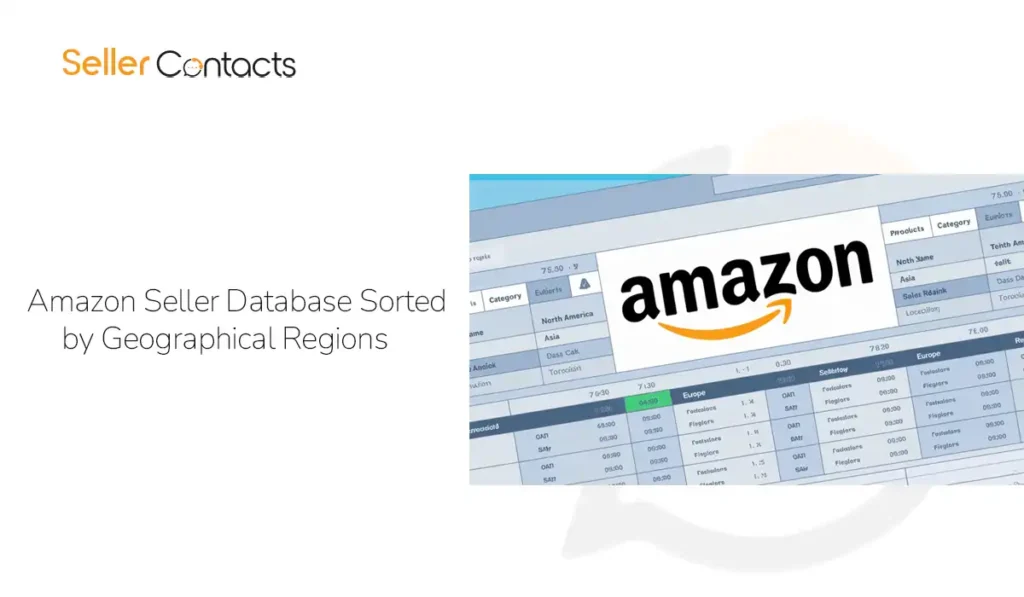Amazon Seller Database Sorted by Geographical Regions

Having access to an Amazon seller database sorted by geographical region allows businesses to target sellers with precision, enhance outreach strategies, and uncover market-specific opportunities. Whether you’re a marketing agency, a SaaS provider, or an exporter, this article will help you understand the benefits of region-specific seller data and how to leverage it effectively.
Who Needs Region-Specific Amazon Seller Databases?
Segmenting seller databases by geographical regions offers tailored insights for businesses operating across various industries:
Marketing Agencies
Marketing professionals can design highly localized campaigns by focusing on sellers in specific regions. For instance:
- A U.S.-based agency can identify top-rated sellers in North America.
- A global agency can target emerging sellers in Asia-Pacific or Europe to expand its clientele.
Exporters and Manufacturers
Suppliers can identify high-volume sellers in their target regions, simplifying the process of forming partnerships or closing bulk deals. For example, exporters can:
- Approach sellers in Europe who specialize in electronics.
- Build connections with North American sellers in the home improvement niche.
E-commerce Consultants
Consultants can focus on region-specific trends and challenges, offering tailored solutions such as:
- Optimization of listings for Amazon marketplaces in Europe.
- Localization strategies for sellers targeting international markets.
B2B Service Providers
Service providers offering logistics, warehousing, or payment solutions can prioritize specific markets. For example:
- A logistics provider can target sellers in Asia-Pacific needing better shipping options.
- A payment gateway provider can approach sellers expanding to Latin America.
Benefits of Sorting Amazon Seller Databases by Geographical Regions
Localized Marketing Campaigns
Sorting databases by region enables businesses to:
- Craft messages that resonate with local cultures and languages.
- Address region-specific challenges like shipping regulations or market competition.
Improved ROI
Targeting sellers within a specific region ensures campaigns are more relevant, leading to:
- Higher conversion rates.
- Better use of marketing budgets.
Competitor Analysis
Understand competitors’ performance across different regions, helping to identify:
- Regional market gaps.
- Opportunities for entering untapped markets.
Strategic Partnerships
Geographical data makes it easier to:
- Form partnerships with top-performing sellers in specific regions.
- Collaborate with sellers expanding into your target markets.
How to Build a Geographically Sorted Amazon Seller Database
Step 1: Define Your Target Regions
Start by identifying the regions you want to focus on. For example:
- North America: U.S., Canada, Mexico.
- Europe: UK, Germany, France, Italy, Spain.
- Asia-Pacific: China, India, Australia, Japan.
Step 2: Collect Data
Gather data using methods like:
- Amazon’s Seller Central: Extract region-specific data.
- Web Scraping: Focus on marketplaces in your target regions.
- Third-Party Tools: Use tools designed to provide region-specific seller data.
Step 3: Organize Data by Region
Organize your data to include fields such as:
- Seller name.
- Region/marketplace.
- Revenue.
- Contact details.
Step 4: Validate and Update Data
Regular updates ensure your database stays relevant as sellers’ performance changes. Cross-check entries against multiple sources to maintain accuracy.
Challenges in Building Region-Specific Databases
Building a geographically sorted database comes with unique challenges:
- Data Privacy Laws: Ensure compliance with region-specific regulations like GDPR in Europe.
- Market Dynamics: Seller data may quickly become outdated due to market fluctuations.
- Technical Complexity: Building a reliable, region-specific database requires advanced tools and expertise.
How to Obtain a Geographically Sorted Amazon Seller Database
Third-Party Providers
Third-party providers like SellerContacts offer pre-built, region-sorted Amazon seller databases. Here’s how they simplify the process:
- Access to detailed, accurate data for multiple regions.
- Regular updates to ensure the database reflects market changes.
- Easy integration with CRM systems for streamlined workflows.
Using Amazon’s API
For businesses with technical expertise, Amazon’s API allows access to marketplace-specific seller data. While powerful, this approach requires significant resources and adherence to Amazon’s guidelines.
Custom Solutions
For unique requirements, some companies offer custom database solutions tailored to your target regions and business goals.
SellerContacts: The Best Source for Region-Sorted Seller Databases
SellerContacts specializes in providing region-specific Amazon seller databases, offering unparalleled data quality and coverage. Here’s what makes them stand out:
- Global Reach: Data from over 50 countries, including top-performing regions like North America, Europe, and Asia-Pacific.
- Actionable Insights: Access key metrics like seller revenue, ratings, and product categories.
- Regular Updates: Stay ahead with monthly updates that reflect marketplace trends.
- User-Friendly Formats: Databases are compatible with CRM tools like HubSpot and Salesforce.
Bottom Line
Sorting Amazon seller databases by geographical regions allows businesses to localize their strategies, improve campaign relevance, and maximize ROI. Whether you’re targeting a specific marketplace or expanding globally, region-specific data gives you the edge needed to succeed.
Ready to elevate your lead generation efforts? Partner with SellerContacts to access accurate, region-sorted seller data that drives results.
